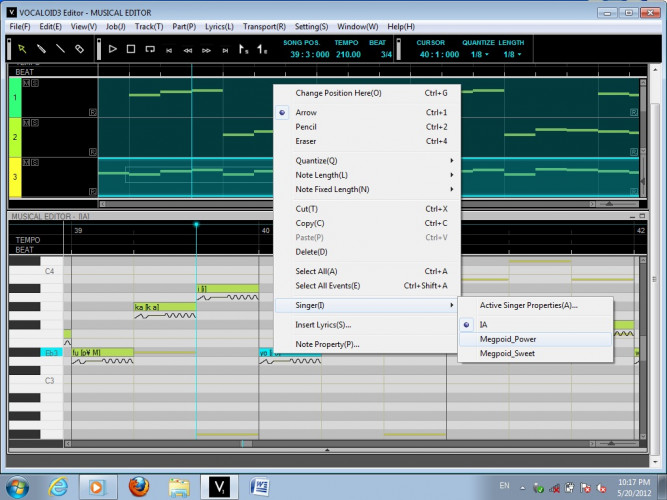

HRP-4Ccosplaying as Gumi, a mascot of Megpoid, at CEATEC JAPAN 2009 The engine calculates a desired pitch from the notes, attack time, and vibrato parameters, and then selects the necessary samples from the library. Pitch conversion Since the samples are recorded in different pitches, pitch conversion is required when concatenating the samples.

No timing adjustment would result in delay. Vocaloid keeps the 'synthesized score' in memory to adjust sample timing so that the vowel onset should be strictly on the 'Note-On' position. The starting position of a note ('Note-On') must be the same as that of the vowel onset, not the start of the syllable. Timing adjustment In singing voices, the consonant onset of a syllable is uttered before the vowel onset is uttered. When Vocaloid runs as VSTi accessible from DAW, the bundled VST plug-in bypasses the Score Editor and directly sends these messages to the Synthesis Engine. The Synthesis Engine receives score information contained in dedicated MIDI messages called Vocaloid MIDI sent by the Score Editor, adjusts pitch and timbre of the selected samples in frequency domain, and splices them to synthesize singing voices. Due to this linguistic difference, a Japanese library is not suitable for singing in eloquent English.

Thus, more diphones need to be recorded into an English library than into a Japanese one. On the other hand, English has many closed syllables ending in a consonant, and consonant-consonant and consonant-voiceless diphones as well. In Japanese, there are basically three patterns of diphones containing a consonant: voiceless-consonant, vowel-consonant, and consonant-vowel. Japanese has fewer diphones because it has fewer phonemes and most syllabic sounds are open syllables ending in a vowel. Japanese requires 500 diphones per pitch, whereas English requires 2,500. In order to get more natural sounds, three or four different pitch ranges are required to be stored into the library. The Vocaloid system changes the pitch of these fragments so that it fits the melody. For example, the voice corresponding to the word 'sing' () can be synthesized by concatenating the sequence of diphones '#-s, s-I, I-N, N-#' (# indicating a voiceless phoneme) with the sustained vowel Ä«.
#VOCALOID 4 EDITOR DOWNLOAD LICENSE#
System architecture Įach Vocaloid license develops the Singer Library, or a database of vocal fragments sampled from real people.The database must have all possible combinations of phonemes of the target language, including diphones (a chain of two different phonemes) and sustained vowels, as well as polyphones with more than two phonemes if necessary. They cannot naturally replicate singing expressions like hoarse voices or shouts.
#VOCALOID 4 EDITOR DOWNLOAD SOFTWARE#
The Vocaloid and Vocaloid 2 synthesis engines are designed for singing, not reading text aloud, though software such as Vocaloid-flex and Voiceroid have been developed for that. 'Singing Articulation' is explained as 'vocal expressions' such as vibrato and vocal fragments necessary for singing.


 0 kommentar(er)
0 kommentar(er)
